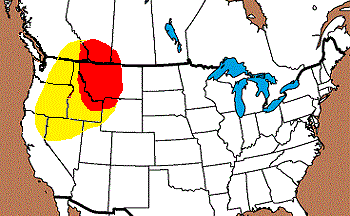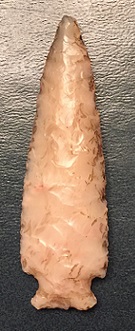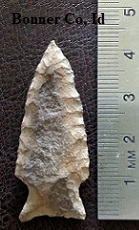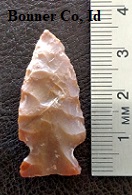Name Details:
Named By: Earl H. Swanson Jr. and Paul G. Sneed
Named For: Type site location, Salmon River, Idaho
Date Identified: 1966
Type Site: Shoup Rockshelter, Lemhi County, Idaho
Salmon River Fishtail
(Bitterroot Variant)
Cluster: Northern Side Notch Cluster
Date:
Cultural Period:
7,500 - 6,500 B.P.
Early to Middle Archaic
Middle Holocene
Glacial Period:
Culture:
Outline is Representative of Size and Shape:
Description of Physical Characteristics and Flaking Pattern:
This is a medium triangular side notch point with an elliptical cross
section. The blade is excurvate and commonly curves back in towards the shoulders. Wide shallow parallel notches enter low on the blade forming a shoulder that is at an upward angle and an
expanding stem. The low notch removes some of the corner of the preform reducing the width of the stem and commonly giving the point a "fishtail" appearance. The base may range from straight to
slightly concave or slightly convex. This point has a random flaking pattern.
Size Measurements: Data Needed / See Bitterroot for similar
size measurements
Distribution:
Distribution Comments:
This point is primarily found in northern Idaho, northwestern Wyoming, western Montana, and into southern Alberta, southeastern British Columbia, and southern Saskatchewan (red). (see
additional comments regarding Columbia Plateau distribution (yellow)).

Additional Comments:
This point was identified by Swanson and Sneed (1966) based on examples found at the Shoup Rockshelter. Swanson and Sneed felt that this was a local variant of the Bitterroot Side Notch and that this type
was limited to the Shoup Rockshelter. Peck (2011) has identified this type extends into Alberta and into British Columbia, within the normal distribution of the Bitterroot type
.
***
Collector type references place this type in the Columbia Plateau and into Nevada and California which is outside the normal distribution of the Bitterroot type. However, Homer (1980) tried to define the
difference between the Bitterroot Side Notch, Cold Springs, and Northern Side Notch types and found that there was no measurable difference between these types and the the only distinguishable difference is the
distribution of these types. If these three types are essentially the same type then the distribution of the Salmon River point may extend into these regions. However, if the Bitterroot is a single unique
type then distribution should not extend into these areas.
Peck (2011) suggests the name Salmon River Ovate Base for examples with a convex base.
Loyd Doty reports:
SALMON RIVER (Stemmed) – was named by archaeologists Earl H. Swanson Jr. and Paul G. Sneed, after the Salmon River Indian band and for examples recovered from the Salmon River (Shoup)
Rockshelters (10LH63) near Shoup, in Lemhi County, Idaho. A Bitteroot variant, they are medium sized (2” to 2 ½”), narrow projectiles and knives with tapered shoulders,
elongated side indentations, short, expanded stems, sharp to round basal corners and straight bases. Distribution includes Idaho, Oregon, Washington and they were in use
during the Early Archaic period. Reference: Swanson, Earl Herbert & Paul G. Sneed 1966, The Archaeology of the Shoup Rockshelters in East Central Idaho. Birch Creek Papers
No. 3, Idaho State University Museum Occasional Papers No. 17
Other points in this Cluster:
Point Validity: Valid Type
Swanson was a distinguished anthropologist and expert on the archaeology of Idaho. He
conducted extensive studies in the Snake River Valley and greatly improved our understanding of archaeology of Idaho. Sneed conducted many studied into the archaeology of Idaho with Swanson and continued on to
study the archaeology of British Columbia. This is a variant of the Bitterroot type and has many professional references. This is considered a valid type.
.
Age Details:
Pictures Provided By:
Stephan Grimes
Tucker Stefan
Special Thanks to Loyd Doty for providing additional information
References: (See Reference Page, Entry Number):
23, 76
Salmon River Projectile Point, Salmon River Arrowhead


